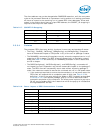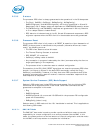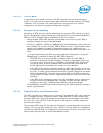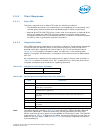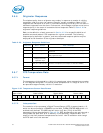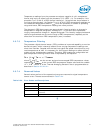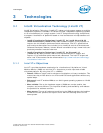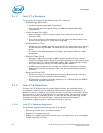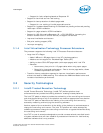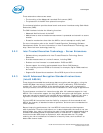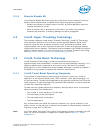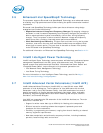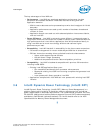
Intel® Xeon® Processor E5-1600/E5-2600/E5-4600 Product Families 79
Datasheet Volume One
Technologies
3 Technologies
3.1 Intel® Virtualization Technology (Intel® VT)
Intel® Virtualization Technology (Intel® VT) makes a single system appear as multiple
independent systems to software. This allows multiple, independent operating systems
to run simultaneously on a single system. Intel VT comprises technology components
to support virtualization of platforms based on Intel architecture microprocessors and
chipsets.
• Intel® Virtualization Technology (Intel® VT) for Intel® 64 and IA-32
Intel® Architecture (Intel® VT-x) adds hardware support in the processor to
improve the virtualization performance and robustness. Intel VT-x specifications
and functional descriptions are included in the
Intel® 64 and IA-32 Architectures
Software Developer’s Manual, Volume 3B
and is available at http://www.intel.com/
products/processor/manuals/index.htm
• Intel® Virtualization Technology (Intel® VT) for Directed I/O
(Intel® VT-d) adds processor and uncore implementations to support and
improve I/O virtualization performance and robustness. The Intel VT-d spec and
other Intel VT documents can be referenced at http://www.intel.com/technology/
virtualization/index.htm.
3.1.1 Intel VT-x Objectives
Intel VT-x provides hardware acceleration for virtualization of IA platforms. Virtual
Machine Monitor (VMM) can use Intel VT-x features to provide improved reliable
virtualized platform. By using Intel VT-x, a VMM is:
• Robust: VMMs no longer need to use para-virtualization or binary translation. This
means that they will be able to run off-the-shelf OS’s and applications without any
special steps.
• Enhanced: Intel VT enables VMMs to run 64-bit guest operating systems on IA x86
processors.
• More reliable: Due to the hardware support, VMMs can now be smaller, less
complex, and more efficient. This improves reliability and availability and reduces
the potential for software conflicts.
• More secure: The use of hardware transitions in the VMM strengthens the isolation
of VMs and further prevents corruption of one VM from affecting others on the
same system.



